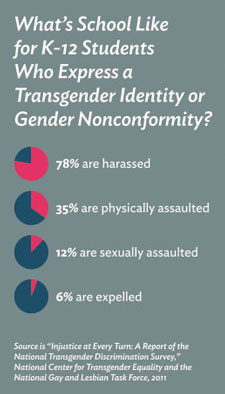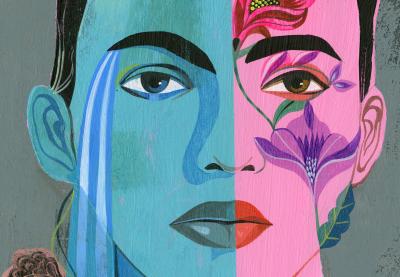When we meet a newborn baby, most of us ask the same question: boy or girl? Often, the answer is easy. Often, but not always.
Meet Alex, a fourth-grader in Madison, Wis., with long, blond hair, a lanky build and a broad smile. When you meet Alex, you see a clever, confident kid who can move a mile a minute. You see what is obvious.
Boy or girl?
When we meet people for the first time, we look for gender cues in a way so automated we don’t even know we’re doing it. Long hair? Dress? Makeup? Female. Buzz cut? Broad shoulders? Ball cap? Male. We make these categorizations in a split second dozens of times every day.
Then someone like Alex (we used a pseudonym to protect Alex’s privacy) walks into the room, and everything we thought we knew about gender flies out the window.
Gender may seem simple, but the myths surrounding this concept mask its true complexity. Experts who work with youth and gender issues tell us the two most common myths are these: First, gender is binary, offering only two options; second, gender and sex are the same thing. Summed up, the myth goes like this: Every person is either male or female, and the distinction is based on that person’s anatomy.
In the parlance of gender development, sex exists between your legs—it’s your biology, your chromosomes, your anatomy. Gender exists between your ears—it’s how you feel about yourself. Kids develop a sense of gender identity by age two or three, says Diane Ehrensaft, author of Gender Born, Gender Made.
For most kids, birth sex and gender identity match. This population is referred to as being cisgender. In some cases, though, children’s gender identity—how they feel about themselves—differs from their biology. Some kids know their gender identities and birth sexes don’t match almost as soon as they begin to talk. For some it is as simple as wishing to swap one gender for another—“I was born a girl, but I’m really a boy.” For others, their sense of gender exists somewhere between male and female, at various points along what is known as the gender spectrum.
The terminology used to describe these identities is vast and evolving. Gender nonconforming and transgender (the “T” in LGBT) are common terms. Increasingly popular are such phrases as gender independent, gender creative, gender expansive and gender diverse.
The common meaning of these terms: The rigid expectations of my birth sex do not match my understanding of who I am.
Alex has adamantly shirked gender boxes since the age of three, refusing to be called boy or girl. Alex doesn’t mind alternating between gendered pronouns, “he” or “she,” though Alex feels most comfortable chucking pronouns altogether. Alex’s preferred gender descriptor is gender fluid.
Gender-diverse kids like Alex face a plethora of binary gender expectations in school: girl/boy lines, seating charts, bathrooms, locker rooms and dress codes. There are rules about who can play “Annie” in the school play, wear a tuxedo to the prom, try out for the football team or be voted homecoming queen.
Then there is the conflation of gender identity—how we feel on the inside—and gender expression—how we present our gender to the world through hairstyle, clothing and behaviors.
Gender expression is often curtailed by our society’s gender norms—the expectations and assumptions that govern how a girl or boy is supposed to look, act, dress and play. These arbitrary norms are ubiquitous: Children’s toothbrushes come in pink or blue; the toy aisles in big box stores are labeled girl (full of dolls and kitchen sets) and boy (full of trucks, LEGO sets and toy tools).
Miriam Hall, a contributor to the anthology Trans-Kin: A Guide for Family and Friends of Transgender People, shares the story of a friend’s 11-year-old son who dresses in pink and loves sparkles and dolls. “He is very clear at all times that he is a boy,” says Hall.
When people mistake him for a girl, he says, “Boys get to be like this. Anyone can be like this. Don’t limit me to what you think boys are.”
Gender Diversity: Words You Should Know
Assigned Sex
The sex that is assigned to an infant at birth based on the child’s visible sex organs, including genitalia and other physical characteristics. Often corresponds with a child’s assigned gender and assumed gender.
Gender Identity
One’s innermost feeling of maleness, femaleness, a blend of both or neither. One’s gender identity can be the same or different from their sex assigned at birth.
Gender Expression
External appearance of one’s gender identity, usually expressed through behavior, clothing, haircut or voice, and which may or may not conform to socially defined behaviors and characteristics typically associated with being masculine or feminine.
Cisgender
Describes a person whose gender identity aligns with the sex assigned to them at birth.
Biological Sex
A medical classification that refers to anatomical, physiological, genetic or physical attributes that determine if a person is assigned male, female or intersex identity at birth. Biological sex is often confused or interchanged with the term “gender,” which encompasses personal identity and social factors, and is not necessarily determined by biological sex.
Binary System
Something that contains two opposing parts; binary systems are often assumed despite the existence of a spectrum of possibilities. Gender (man/woman) and sex (male/female) are examples of binary systems often perpetuated by our culture.
Genderqueer
Describes a person who rejects static categories of gender (i.e. the gender binary of male/female) and whose gender expression or identity falls outside of the dominant social norms of their assigned sex. They may identify as having aspects of both male and female identities, or neither.
Transgender
An umbrella term for people whose gender identity differs from the sex they were assigned at birth. Not all trans people undergo transition. Being transgender does not imply any specific sexual orientation. Therefore, transgender people may identify as straight, gay, lesbian, bisexual or something else. Also, trans.
Preferred Pronouns
The pronoun or set of pronouns that an individual personally uses and would like others to use when talking to or about that individual. Can include variations of he/him/his, she/her/hers, they/their/theirs, among others. This term is being used less and less in LGBTQ circles, as it suggests one’s gender identity is a “preference” rather than innate. Recommended replacement: “Your pronouns, my pronouns, their pronouns, etc.”
For a longer list of terms, click here.
Compared to the general population, gender-diverse kids face drastically increased rates of bullying, assault, depression, school drop-out, drug abuse, self-harm and suicide. A 2009 report from the Gay, Lesbian and Straight Education Network paints a grim picture. Nearly 90 percent of transgender youth surveyed had experienced verbal harassment at school because of their gender expression. Two-thirds expressed feeling unsafe at school; more than half experienced physical harassment. A quarter experienced physical assault. Most of these incidents were never reported to school officials.
Students in the study who experienced high levels of gender-identity harassment were more likely to skip school for safety reasons and to have significantly lower grade-point averages than their peers who experienced little to no harassment.
To protect their child from these negative outcomes, Alex’s parents choose teachers carefully and prep them in advance. Even so, there have been growing pains. After an incident in the boys’ bathroom early on, the school agreed to let Alex use a unisex staff bathroom in the upper-grade wing. Alex knows every circuitous route to get there without being singled out or teased.
For the most part, the school has reacted to Alex with an openness that will hopefully inspire other communities. Gone are the boy/girl lines, the gendered play areas and pronouns. Recently, Alex’s mother, Katherine (also a pseudonym), overheard a teacher casually refer to another child as gender expansive. “That word wasn’t in her vocabulary before,” Katherine says. “This is a journey, and everyone is learning.”
Still, every day for Alex involves some form of navigation. Substitute teachers, custodians, school visitors, new kids, school forms with gendered checkboxes and restroom dilemmas on field trips—the question reappears over and over again in the gendered expectations of people and society: Are you a boy or girl?
A gender-diverse child’s best predictor of success is whether that child receives support at home and from teachers. Often, families push schools to make the necessary changes for their children. But for kids who don’t have support at home, informed and sympathetic educators are their only chance for a safe place.
 Students have a better chance of success “when there are available resources and support, whether it’s a clearly identified teacher with a ‘Safe Zone’ sticker on the door, an LGBT resource person on staff or a section of the library with resources for gender and sexual identity,” says Stephen Russell, a professor of family studies and human development at the University of Arizona whose work has shed light on the gender experiences of children.
Students have a better chance of success “when there are available resources and support, whether it’s a clearly identified teacher with a ‘Safe Zone’ sticker on the door, an LGBT resource person on staff or a section of the library with resources for gender and sexual identity,” says Stephen Russell, a professor of family studies and human development at the University of Arizona whose work has shed light on the gender experiences of children.
One modest but important step educators can take: Make explicit at the start of the school year that in your classroom, everyone deserves respect and that making fun of people based on gender identity or expression won’t be tolerated.
If your school or district offers resistance, request professional development to educate teachers about gender diversity. “The majority of our teachers were trained at a time when this was not part of teacher education or the norm in public schools,” says Russell.
“We have a cultural lag, and teachers are catching up. It’s OK to say, ‘I need to stop and figure this out.’ Just remember, this isn’t about your values. It’s about your legal and moral obligation to support every child as the best teacher you can be. You don’t have to be supportive of gay rights or gender fluidity to be a resource for a gender-fluid kid—that’s a very important message for teachers to hear.”
“I know this is out of a lot of people’s comfort zones,” says Katherine. “Sometimes I think people would be more comfortable supporting a kid [who] wants to switch genders than a child who is neither one.”
Right now, though, Katherine’s child is simply a 10-year-old looking forward to an evening at a friend’s house. Alex’s biggest worry right now is finding the misplaced proceeds from a craft fair, where Alex and a friend sold hand-woven friendship bracelets. Right now, Alex is as well-adjusted and carefree as fourth-graders come.
So, boy or girl? Perhaps we’ve been asking the wrong question all along.
Creating a Gender-Inclusive Classroom
“Teachers can make a big difference in the lives of kids by doing really simple things,” says Joel Baum, director of education and training at Gender Spectrum, a national organization that helps schools create gender-inclusive spaces for all kids.
Start by asking yourself a few questions.
- What is my gender story? Have I ever experienced limitations because of gender norms? Do I have any gender biases? (Addressing your own issues first can help clear the way for authentic relationships with your students.)
- Does my district or school’s anti-bullying policy expressly protect students from harassment based on gender identity? (Most don’t. The ones that do have the best results.)
- Does my curriculum include neutral or positive mention of LGBT people?
- Do I communicate a nonbinary understanding of gender to my students through the visuals on my classroom walls, the books on the shelves and the language I use? (For example, in place of calling “boys and girls” to the rug, invite “all readers.”)
- Does my school have a Gay-Straight Alliance (GSA) and, if so, does it work to actively include gender-diverse students? If not, do I have a “Safe Space” sticker on my door, so students know they can talk with me? (Research shows students who have access to GSAs do better in school. Resiliency studies show that often kids need just one openly supportive adult in their lives to overcome obstacles.)
- Am I working with parents and students to ensure the safety of gender-diverse students? (Many parents may be supportive of gender diversity at home, yet prevent their child from expressing nonbirth gender at school for fear their child may not be safe there.)

